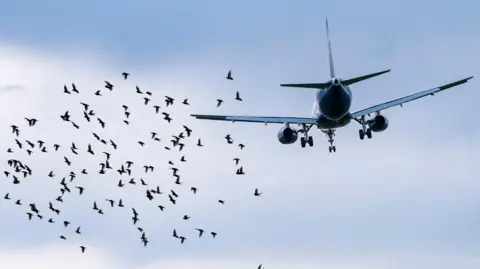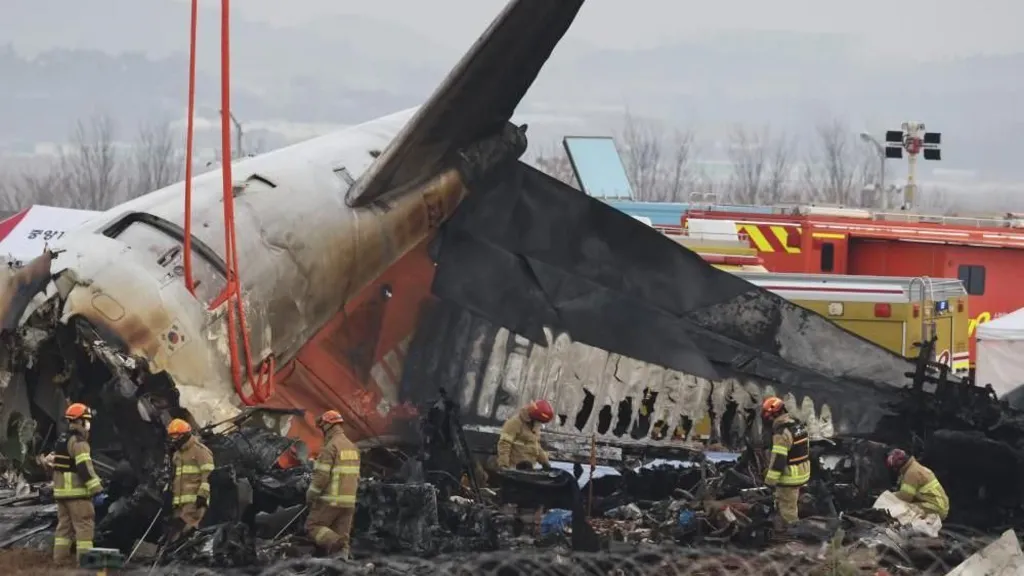The Jeju Air aircraft erupted in flames upon crash-landing at Muan International Airport, leaving only two crew members alive.
Acting President Choi Sang-mok has urged investigators to swiftly share their findings with the grieving families.
This directive follows another incident on Monday, when a Jeju Air flight returned to Seoul shortly after takeoff due to an unspecified landing gear issue.
On Monday, a Jeju Air plane departed from Gimpo International Airport at 06:35 local time (21:35 GMT Sunday) but returned less than an hour later after identifying a mechanical issue with its landing gear, according to South Korea’s Yonhap news agency.
The landing gear, comprising the wheels and structural components supporting the aircraft during takeoff, taxiing, and landing, was identified as the source of the problem.
The plane that turned back, a Boeing B737-800, is the same model as the aircraft involved in Sunday’s tragic crash. Of Jeju Air’s fleet of 41 planes, 39 are this model.
Boeing has stated it is in contact with Jeju Air and is “ready to support them” following the crash.
Sunday’s accident involved flight 7C2216, carrying 179 passengers aged between three and 78, most of whom were in their 40s, 50s, and 60s, according to Yonhap. Two Thai nationals were among the victims, while the remaining passengers are believed to have been South Korean.
The plane skidded off the runway and crashed into a wall shortly after landing at Muan International Airport at around 09:00 local time (00:00 GMT).
Authorities reported that the plane had initially been directed to hold off landing due to a bird strike warning issued by air traffic control. It was later cleared to land from the opposite direction, but tragedy struck during the attempt.
Jeju Air executives publicly apologized during a press conference on Sunday, bowing deeply as they expressed their regrets. “We deeply apologize to all those affected by this incident. We will do everything in our power to address the situation,” the airline stated.
Shares of Jeju Air fell by approximately 8% on Monday.
The crash comes as a national tragedy for South Korea, which is already grappling with political turmoil following the impeachment of President Yoon Suk Yeol. Acting President Choi Sang-mok, who assumed the interim role on Friday, expressed deep sorrow over the disaster.
“To the honorable citizens of our nation, as acting president, my heart aches as we face this unforeseen tragedy amid recent economic hardships,” Choi said.
Could a bird strike have caused S Korea plane crash?
South Korean officials have launched an emergency safety investigation following the country’s deadliest plane crash on Sunday, which claimed 179 lives.
Just before the flight was set to land, air traffic control issued a bird strike warning, alerting the crew to the potential risk of a collision with birds.
The investigation aims to determine whether a bird strike was the cause of the crash or if other factors played a role.
What is a bird strike?
A bird strike occurs when a bird collides with an aircraft in flight.
These incidents can be hazardous, as jet engines may lose power if birds are drawn into them.
Bird strikes are a frequent occurrence. In 2023, over 19,600 wildlife strikes were reported to the U.S. Federal Aviation Administration, most of which involved birds.
In the UK, more than 1,400 bird strikes were recorded in 2022, although only around 100 had an impact on aircraft, according to data from the Civil Aviation Authority.

How dangerous are bird strikes?
Bird strikes are rarely linked to fatal plane crashes.
While birds entering jet engines can cause them to stall or shut down, pilots typically have time to respond and perform an emergency landing.
According to aviation expert Professor Doug Drury, writing for The Conversation, pilots are trained to be particularly cautious during early morning or sunset hours when bird activity is highest.
However, deadly bird strike incidents do occur. Between 1988 and 2023, wildlife collisions resulted in 76 fatalities in the U.S., according to the Federal Aviation Administration (FAA).
One notable tragedy occurred in 1995 near an Air Force base in Alaska, where 24 Canadian and American airmen lost their lives after their aircraft struck a flock of geese.
A more well-known bird strike incident is the 2009 “Miracle on the Hudson,” where an Airbus plane collided with geese shortly after takeoff. The pilots successfully ditched the plane onto New York’s Hudson River, saving all 155 passengers and crew.
This event was later dramatized in the 2016 film Sully, starring Tom Hanks as Captain Chesley “Sully” Sullenberger.
Did a bird strike cause the plane crash in South Korea?
Officials have yet to confirm whether the plane involved in Sunday’s crash collided with birds.
However, local media reported that a passenger on the flight messaged a relative, claiming a bird “was stuck in the wing” and that the aircraft could not land.
Lee Jeong-hyun, chief of the Muan fire department, stated that both a bird strike and adverse weather conditions might have contributed to the crash, but the exact cause remains under investigation.
Aviation expert Chris Kingswood, a pilot with over 40 years of experience and familiarity with the aircraft model involved, said video footage of the incident does not clearly reveal the cause.
Kingswood observed that the plane was missing its landing gear and did not use its flaps in the usual manner, suggesting “everything happened really quite quickly.”
“You would typically only encounter such a scenario if both engines failed,” he told the BBC. “A commercial aircraft can still fly safely on one engine.”
Kingswood emphasized the importance of altitude in managing dual engine failure. Pilots at lower altitudes face “a huge number of decisions in a very short amount of time.”
He noted that an alternative system exists to operate both the landing gear and flaps in case of engine failure. However, if the plane was at a low altitude, “the priority would be to focus on flying the aircraft and finding a safe landing spot.”
Other experts have raised doubts about whether a bird strike alone could have caused the crash.
“A bird strike is not unusual, and issues with landing gear are not uncommon,” Geoffrey Thomas, editor of Airline News, told Reuters. “Bird strikes occur far more frequently, but they typically do not result in the loss of an aircraft.”
Australian airline safety expert Geoffrey Dell added: “I’ve never seen a bird strike prevent the landing gear from being extended.”
Dell acknowledged that a bird strike could have damaged the engines if a flock was involved, but noted that engine shutdown would not happen immediately, allowing pilots some time to respond.
